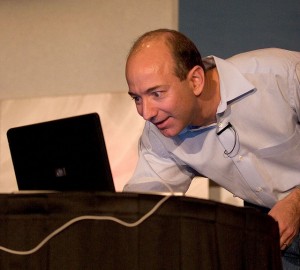 Jeff Bezos has a loud laugh. But Amazon.com’s founder and CEO is keeping quiet about his expansion efforts, which now include sites as varied as BuyVIP.com, Zappos, and as of Monday, Diapers.com.
Jeff Bezos has a loud laugh. But Amazon.com’s founder and CEO is keeping quiet about his expansion efforts, which now include sites as varied as BuyVIP.com, Zappos, and as of Monday, Diapers.com.
With its many acquisitions, Amazon.com is turning itself into a multibrand retailer. You’d never glean this from the company’s strategy statements in its annual reports, where it talks about “the strength of our brand” — not brands. Amazon’s PR boilerplate gushes at length about the Kindle e-book reader but not, say, DPReview, Shopbop, Javari, IMDB, Small Parts, or Fabric.com — all of which Amazon owns.
Amazon’s e-commerce empire is barely integrated. Want to log in to Zappos with your Amazon account, or use your Amazon Prime membership to get free two-day shipping at Fabric.com? Good luck with that. (In fact, two years after Amazon.com bought Fabric.com, the site is still apparently run by a third-party e-commerce operator, Bridgeline Digital.) Only Endless.com, a shoes-and-handbags site launched in-house, and Small Parts are “powered by Amazon.com,” a status which means Amazon.com customers can use their accounts on those sites. You have to dig into the legalese of privacy policies or ferret out obscure “About” pages to find a mention of Amazon.com on many of the sites it owns. For all of its talk of building and leveraging the Amazon.com brand, Amazon does little to broadcast it off of the mothership.
That hands-off approach may actually be an asset to Amazon’s merger and acquisitions strategy. Quidsi cofounder Vinnie Bharara told me that the example of Zappos factored into his and cofounder Marc Lore’s decision to sell the parent company of Diapers.com to Bezos & co.
Still run under CEO Tony Hsieh, Zappos continues to operate under its quirky culture, which emphasizes high-quality customer service instead of low prices. New Zappos hires are paid as much as $3,000 to quit after training, a test of their commitment to the company. It’s hard to imagine Amazon applying that broadly across the company, but it’s let Zappos continue the practice.
Multibrand retail has a mixed reputation offline. Gap Inc. has struggled to differentiate its Gap and Old Navy brands. Limited has had a breakout success with Victoria’s Secret, but it’s not clear how the lingerie-store chain has benefited from being owned by the same company as Bath & Body Works. And Macy’s has gone from a panoply of department-store brands to just two: Macy’s and Bloomingdale’s.
Online, though, things are different. The cost of operating a Web brand is far less than running a retail chain, and it’s far easier to experiment. Zappos and Diapers.com built their brands largely through customer service and word of mouth, not expensive advertising.
Ultimately, the only question that matters is whether shareholders are losing out by Amazon’s lax approach to integrating its retail holdings. And the answer is, likely not. Amazon can get economies of scale in sourcing products and processing payments. And Amazon’s brand, which stands for convenience, selection, and low prices, may not scale to every customer in the retail world. By allowing Zappos and Quidsi to innovate under the Amazon umbrella, Bezos can better fend off rivals — while keeping potential assets out of their hands. (Walmart was reportedly interested in Quidsi.)
What’s next? According to Quidsi’s Lore, the company is planning to go ahead with the launch of Yoyo.com, after reportedly paying $500,000 for the domain name. Does the world need another toys site to compete with Amazon.com’s vast selection of toys? Here’s the thing: With Yoyo.com in his pocket, Bezos will be the first to know.
[Photo: oreilly]
VentureBeat's mission is to be a digital town square for technical decision-makers to gain knowledge about transformative enterprise technology and transact. Learn More
